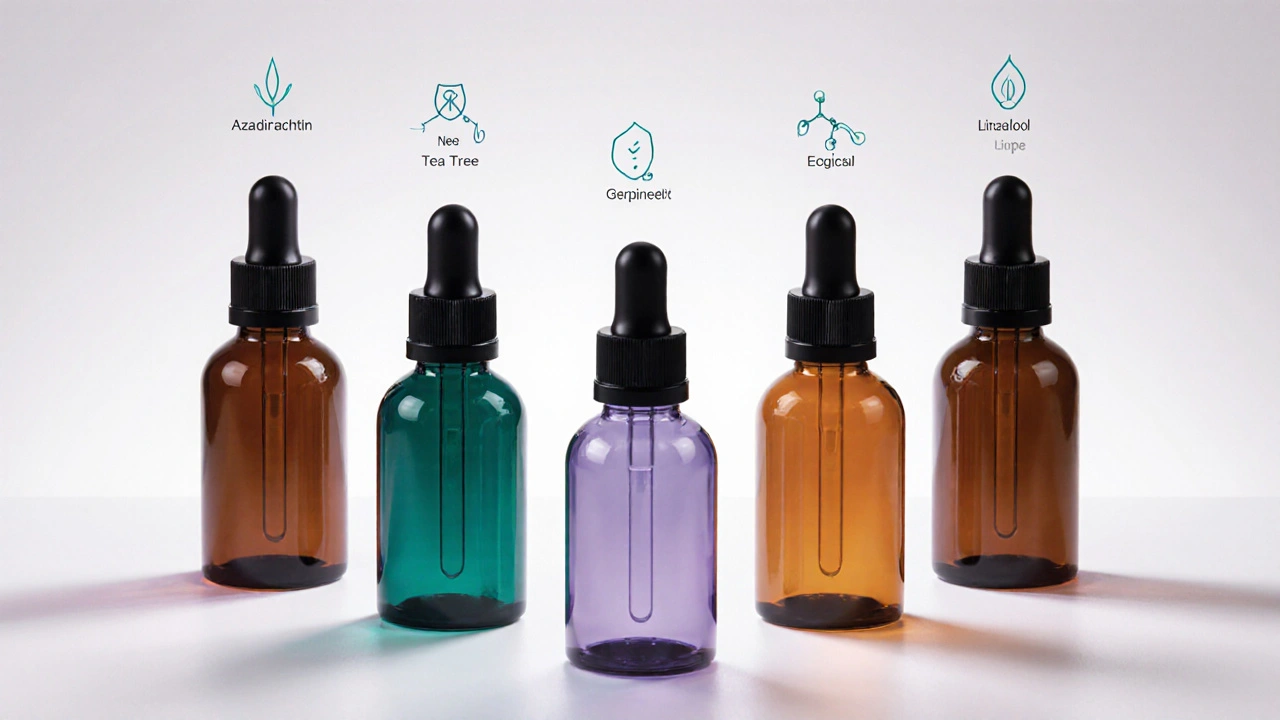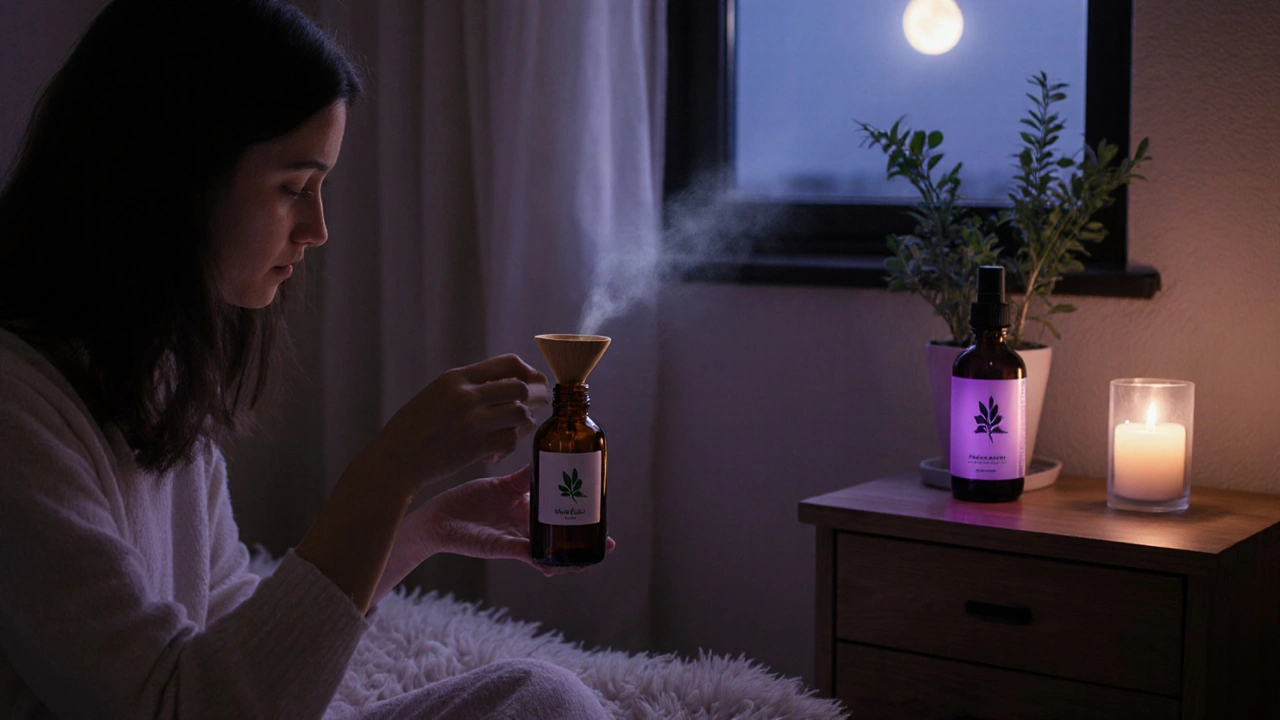Neem vs Natural Alternatives: Comparison Tool
Neem
Azadirachtin, Nimbidin
Tea Tree Oil
Terpinen-4-ol
Oregano Oil
Carvacrol, Thymol
Lavender Oil
Linalool, Linalyl Acetate
Clove Oil
Eugenol
Comparison Results
Select an ingredient above to see detailed comparison with Neem.
When you hear the word "Neem," you probably picture a hardy tree native to India, famed for its bitter leaves and powerful health tricks. But the market is flooded with other herbal oils and extracts promising the same anti‑inflammatory, antimicrobial, and pest‑repellent perks. If you’re trying to decide whether to stick with Neem or reach for something else, you need a side‑by‑side look at what each option actually offers.
TL;DR
- Neem contains azadirachtin, a potent insect‑growth inhibitor, making it ideal for gardening and skin care.
- Tea tree oil excels at bacterial and fungal infections but can irritate sensitive skin.
- Oregano oil has the highest carvacrol content, perfect for gut health but strong enough to need dilution.
- Lavender oil provides calming aroma plus mild antimicrobial action, great for bedtime routines.
- Clove oil’s eugenol is a powerful analgesic for dental pain, yet it’s a skin sensitizer.
- Choose based on target use, safety profile, and how much you mind the scent.
What is Neem?
Neem is a tropical evergreen tree (Azadirachta indica) native to the Indian subcontinent. Its leaves, seeds, bark, and oil are packed with bioactive compounds such as azadirachtin, nimbidin, and quercetin, which give Neem its antibacterial, antifungal, anti‑inflammatory, and insect‑repellent properties. In traditional Ayurveda, Neem has been used for everything from skin disorders to blood‑sugar control. Modern research backs many of these claims: a 2023 clinical trial showed a 30% reduction in acne lesions after a four‑week neem leaf extract regimen, while an agronomy study reported a 45% drop in aphid populations on neem‑treated crops.
Key Attributes of Neem
- Active compound: Azadirachtin (inhibits insect molting)
- Primary uses: Pest control, skin care, oral health, blood‑sugar regulation
- Safety rating: Generally safe for topical use; oral ingestion should be under professional guidance
- Typical concentration: 2-10% for creams, 0.5-2% for oral tinctures
Popular Natural Alternatives
Below are the most common plant‑based oils that people compare with Neem. Each has a distinct chemical profile and a sweet spot of applications.
Tea Tree Oil
Extracted from Melaleuca alternifolia leaves, tea tree oil is famed for its terpinen-4-ol content, which makes it a strong antibacterial and antifungal agent. It’s a staple in acne creams, foot sprays, and dandruff shampoos. However, its pungent scent and potential for skin irritation mean you should patch‑test before full‑area use.
Oregano Oil
Rich in carvacrol and thymol, oregano oil packs a punch against resistant bacteria. Studies from 2022 show it can reduce Staphylococcus aureus colonies by more than 90% when used at 1% concentration. The downside? It’s so potent that undiluted application can cause burning.
Lavender Oil
Distilled from Lavandula angustifolia flowers, lavender oil offers a calming aroma plus mild antimicrobial action. It’s commonly added to sleep masks, pillow sprays, and post‑sun soothing lotions. While gentle on most skin types, its effectiveness against serious infections is limited.
Clove Oil
Derived from the dried flower buds of Syzygium aromaticum, clove oil’s star compound is eugenol, a natural anesthetic. Dentists use it for temporary toothache relief, and it also displays strong antifungal properties. Yet, eugenol can be a skin sensitizer, so dilution is a must.
Basil Oil
Holy basil (Tulsi) oil contains eugenol and linalool, giving it anti‑stress and mild antimicrobial effects. It’s a favorite in Ayurvedic stress‑relief blends and can complement skin‑care routines aimed at reducing redness.
Eucalyptus Oil
Eucalyptus (specificallyEucalyptus globulus) oil is rich in 1,8‑cineole, which helps clear respiratory passages and has modest antibacterial activity. It’s typical in chest rubs and inhalants, but the strong menthol‑like scent may be off‑putting for some users.
Aloe Vera Gel
While not an oil, Aloe Vera gel often appears in the same “natural skin‑care” conversation. It soothes burns, supplies glycans for skin repair, and pairs well with neem or tea tree for a balanced soothing blend.

Side‑by‑Side Comparison
| Herb / Oil | Active Compound(s) | Best‑Fit Use | Safety Rating (Topical) | Typical Dilution |
|---|---|---|---|---|
| Neem | Azadirachtin, Nimbidin | Pest control, acne, oral health | High - low irritation | 2-10% (cream), 0.5-2% (tincture) |
| Tea Tree Oil | Terpinen‑4‑ol | Fungal infections, oily skin | Medium - may irritate | 1-5% (spot), 0.5% (full‑area) |
| Oregano Oil | Carvacrol, Thymol | Gut health, resistant bacteria | Low - strong sensitizer | 0.5-1% (oral), 1% (topical) |
| Lavender Oil | Linalool, Linalyl acetate | Relaxation, mild skin soothing | High - gentle | 2-5% (massage), up to 10% (spray) |
| Clove Oil | Eugenol | Dental pain, antifungal | Low - potential sensitizer | 0.5-1% (oral), 1% (topical) |
How to Choose the Right Option
Think about three practical questions before you reach for a bottle:
- What’s the primary goal? If you need a garden‑friendly insect repellent, neem’s azadirachtin beats any oil. For a quick acne spot, tea tree’s terpinen‑4‑ol is more aggressive.
- How sensitive is your skin? Lavender and neem sit on the gentle side; oregano and clove require careful dilution.
- Do you mind the scent? Neem’s bitter, earthy aroma can be off‑putting in home sprays, whereas lavender and eucalyptus are fragrance‑friendly.
Match your answers to the table above, and you’ll land on the most effective, safest candidate.
Practical Tips for Using Neem and Its Alternatives
- Patch test first. Apply a tiny dab of diluted oil on the inner forearm for 24hours. If no redness or itching appears, it’s safe to expand.
- Combine wisely. A 1:1 mix of neem oil and lavender oil works well in a nighttime facial serum-Neem tackles acne, lavender calms.
- Store properly. Keep oils in dark glass bottles, sealed tightly, away from heat to preserve volatile compounds.
- Follow recommended concentrations. Over‑concentration not only irritates skin but can also diminish the natural benefits of the active compounds.
- Consult a professional. For oral neem preparations or for treating chronic conditions, a qualified practitioner should guide dosage.
Potential Pitfalls and How to Avoid Them
Even “natural” doesn’t mean “risk‑free.” Common mistakes include:
- Skipping dilution. Undiluted neem or oregano oil can cause burns, especially on broken skin.
- Mixing incompatible ingredients. Combining strong sensitizers like clove oil with other potent oils can lead to cumulative irritation.
- Using expired oils. Oxidized compounds lose efficacy and may become irritating allergens.
- Assuming one‑size‑fits‑all dosing. Age, skin type, and health status dictate how much you need.
When you respect these limits, the benefits far outweigh the risks.
Frequently Asked Questions
Is neem safe for daily skin care?
Yes, when formulated at 2‑10% in creams or lotions, neem is gentle enough for daily use. Always do a patch test if you have very sensitive skin.
Can I use neem oil to repel insects at home?
Absolutely. Dilute neem oil to about 5% and spray it on plant leaves, door frames, or pet bedding. Azadirachtin disrupts insect growth cycles, reducing infestations without toxic chemicals.
How does tea tree oil compare to neem for acne?
Tea tree oil works faster because terpinen‑4‑ol kills acne‑causing bacteria on contact. Neem offers a slower, anti‑inflammatory effect that’s gentler for long‑term use. Many people alternate: tea tree for flare‑ups, neem for maintenance.
What concentration of oregano oil is safe for oral use?
Clinical studies suggest 0.5-1% oregano oil in a carrier (like olive oil) taken 1-2 times a day for short periods (up to 2 weeks). Higher concentrations increase the risk of stomach irritation.
Can I mix neem oil with other essential oils?
Mixing is fine as long as the total concentration stays below 10% for skin applications. A popular blend is neem+lavender+carrier oil for a calming, acne‑fighting serum.

Next Steps
Now that you’ve seen the pros and cons, pick one or two candidates that match your primary need. Start with a small test batch, keep a usage log, and adjust the dilution based on how your skin or garden responds. If you hit a snag-like unexpected irritation or low efficacy-re‑evaluate the active compounds and consider swapping to a higher‑potency alternative such as oregano or tea tree, always respecting safety guidelines.
Whether you settle on neem’s all‑round gentle power or chase the high‑impact punch of oregano, the key is informed experimentation. Happy blending!






Reading through the neem comparison, I appreciate the clear tables and the practical tips about dilution; the side‑by‑side format makes it easy to spot which oil suits a particular need. I’ll probably start with a low‑dose neem spray for the garden, since the insect‑repellent claim looks solid.
October 3Brad Tollefson